Kepler mission
All posts tagged Kepler mission
https://arxiv.org/abs/1910.09523
https://en.wikipedia.org/wiki/Kelvin_wave



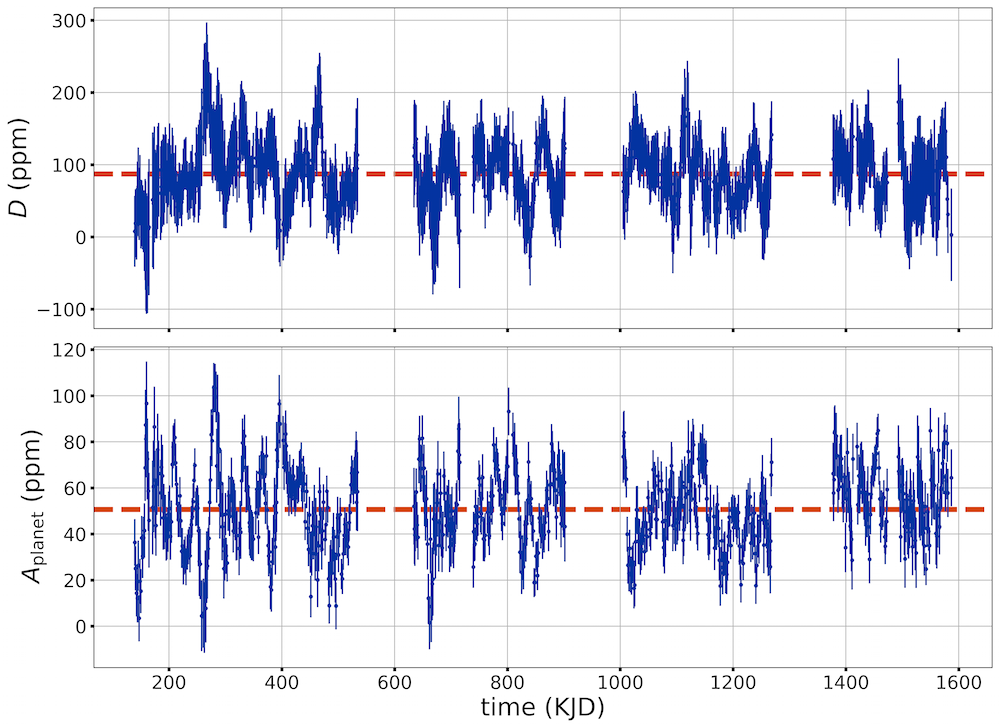
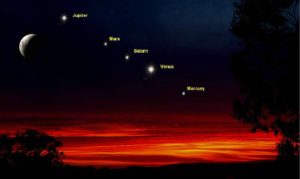
Artist’s impression of planet alignment in 2016. From here.
Anyone who’s done some stargazing has probably noticed that the Sun and the Moon appear along nearly the same arc in the sky. This Sun’s arc, called the ecliptic, corresponds to the plane of the Earth’s orbit. Since all planets in the solar system share nearly the same orbital plane, they likewise hew close to this arc. It turns out that the ecliptic also coincides closely with the Sun’s equator.
The near alignment of all planetary orbits in the solar system is one of the most important clues to their formation – the solar system originated billions of years ago from a thin disk of gas and dust girding the young Sun’s belly like a hula hoop, an idea going back at least to Immanuel Kant in the 1700s called the Nebular Hypothesis.
Once it was accepted, this idea was so successful at explaining and predicting features of the solar system, astronomers believed all planetary systems in our galaxy would resemble our own – with small, rocky planets close to their stars and large, gassy planets farther away, but all sharing the same orbital plane.
The discoveries of thousands of exoplanets have turned all that on its head – planets around other stars have orbits oriented every which way. For example, the Upsilon Andromeda system has three Jupiter-like planets, all on orbits that are widely misaligned.
Although these topsy-turvy planetary orbits were initially puzzling, astronomers are starting to tease out the explanations for these systems. Planets probably do start out in well-aligned orbits, but, like kids in the backseat on a long car trip, jostling between the planets (due to mutual gravitational tugs) soon upsets this delicate arrangement and upends the orbits. In the case of Upsilon Andromeda, planets may even have been ejected from the system.
A recent study from Fei Dai and colleagues explored connections between orbital misalignment and the origins of one puzzling class of exoplanet – small, short-period planets. These planets range in size (and probably composition) from Neptune-like to smaller than Earth but inhabit orbits very close to their host stars, some taking only hours to circle the star. Many of these short-period planets also have sibling planets farther out, and the arrangement of these orbits might tell us how the planets got so close to their stars.
As for the Upsilon Andromeda system, the mutual inclination between the orbits, if its big, may point to a history of violence in the system. Such violence may explain how the short-period planets got so close to their stars – they could have started out far away and been thrown by their siblings toward the star. By contrast, a small mutual inclination could mean the system has always been relatively quiescent, and the short-period planets may have gently migrated inward from farther out.
By analyzing the transit light curves of the planets as observed by the Kepler spacecraft, Dai and colleagues found a pattern in the mutual inclinations for these systems. From their paper, the figure below shows that when the distance of the shortest-period planet in a system a/R* is larger, the mutual inclination ΔI between orbits tends to be less widely distributed.

Figure 3 from Dai et al. (2018).
What does this result mean? Since the short-period planets closest to their stars (small a/R*) also seem to have a very wide range of mutual inclinations, maybe they experience the same kind of gravitational jostling that took place in Upsilon Andromeda, while planets farther out, they were moved in more gracefully.
Taking a wider perspective, evidence is mounting that, while planetary systems are common in the galaxy, our own solar system is unique in many ways – there’s really no place like home.
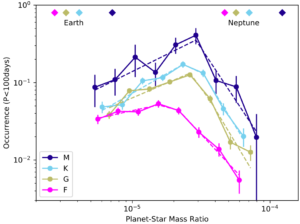
Figure 1: The number of planets per star as a function of the planet-star mass ratio as discovered by Kepler. Dark and light blue curves are for stars less massive than the Sun, while the pink curve is for more massive stars. From Pascucci et al. (2018).
Among the mind-blowing discoveries of the Kepler Mission is that the most common type of planet in the galaxy is the super-Earth/sub-Neptune. This unexpected type of planet straddles the boundary between Earth and Neptune in size and mass, and so they may be super-sized rocky planets or anemic gas-rich planets. We just can’t tell.
Stranger still is that this bizarre chimera orbits one out of every four stars in the Milky Way, but we don’t seem to have one in our solar system (unless the Planet Nine hypothesis pans out).
If that wasn’t enough to make you feel like a planetary outsider, a recent study suggests most planet systems have very different architectures from our own.
In their paper, Prof. Ilaria Pascucci of the University of Arizona and her colleagues studied the distribution of masses for planets discovered by the Kepler Mission. Unlike other recent work, though, they considered not just the planet masses but how they compare to the masses of their parent stars.
Naively, we might expect that more massive stars grow more massive planets, and there is good evidence that more massive stars host more massive dust disks. So as long as the processes that make planets are happy to operate around most any kind of star, then we can use the distribution of planet-star mass ratios to disentangle the influence of stellar mass from other effects.
And Pascucci et al. found exactly what we expected – big stars, small stars, they are all more likely to host planets more massive than Earth — but only up to a point. As shown in Figure 1, the number of planets per star increases with the planet-star mass ratio until it reaches about 0.00003 (or 10 Earth masses for one solar mass) — somewhere between the Earth and Neptune. Above that ratio, the occurrence rate drops, meaning more massive planets are less and less common.
But something even more interesting emerged when Pascucci et al. compared their results based on the Kepler Mission to other surveys. Because Kepler is good at finding planets close to their host stars and not at finding planets farther away, Pascucci’s results don’t tell us much about planets in orbits like Jupiter’s. But microlensing surveys, which use a totally different planet-finding technique, *are* good at finding these more distant planets.
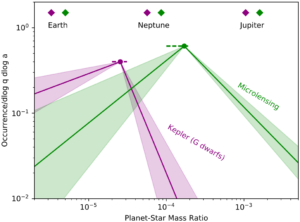
Figure 2: The number of planets around each star with a given planet-star mass ratio for planets close to their host star (as found by Kepler) and planets farther away (as found by microlensing surveys). From Pascucci et al. (2018).
Comparing mass ratios from the two kinds of surveys, Pascucci et al. showed more distant planets found by microlensing also show a preference, but for a ratio several times larger than what’s preferred by closer-in planets — somewhere between Neptune and Jupiter in mass, as shown by the figure above.
What does this all mean? Apparently, the universe seems to like make planets about ten thousand times less massive than their host stars, whether the stars are tiny red dwarfs or massive F-stars. And the farther away the planet is from its star, the more likely it is to be more massive.
Standard planet formation theory predicts this trend: protoplanetary disks (from which planets form) have more solid, icy material farther from the host star, and more solids means more planet.
But these results also make our solar system look even stranger than before. In most solar systems, orbits like Earth’s (and closer) are occupied by planets somewhere between Earth and Neptune in mass, and more distant orbits like Jupiter’s are occupied by planets between Neptune and Jupiter.
It’s tempting to speculate that things that make the solar system unique in one way (in this case, the type of planets we have) are related to other unique things (like, the fact that there’s life here). We don’t know much about super-Earths, but if they turn out to be more Neptune- than Earth-like, it’s not hard to imagine they wouldn’t be good places for life to get started.
Life as we know it needs a planet with a solid surface and lots of liquid water, and so maybe it’s not surprising we haven’t found life elsewhere in the galaxy yet: most of the planets are lifeless, gas balls.
Very neat paper recently published about the possible discovery of comets orbiting a distant star found using data from the Kepler mission.
To find the elusive exocomets, a group led by Prof. Saul Rappaport at MIT conducted an exhaustive search of more than 200,000 lightcurves collected by Kepler over its 3.5 year nominal mission.
By meticulously sifting these lightcurves by hand, Rappaport’s group were able to spot strangely and non-periodic signals, the kinds of signals that computers, with their rigid predictability, have trouble finding.
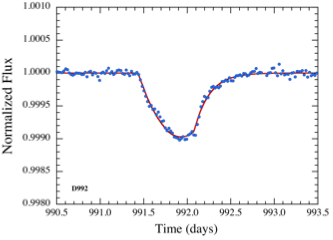
The shadow of an exocomet.
The figure at left shows the shadows of exocomets orbiting a very bright star, a little bigger than the Sun, as they pass between the star and the Earth. The cometary signal is asymmetric and doesn’t occur on a regular schedule, totally unlike an exoplanetary transit.
Rappaport’s group reports seeing six of these strange signals coming from the Kepler target star. Probably most of the signal is coming from a cloud of dust ejected by the exocomet. Such dust ejections are common for comets in our solar system, giving rise to one of the two lustrous tails usually seen for comets (the other tail is made of a stream of ionized plasma).
By fitting a simple dust model to the shadow signals, Rappaport and colleagues estimate that their exocomet is shedding dust at a rate of about 20,000 tons per second, roughly equivalent to the total mass of meteors that burn up in the Earth’s atmosphere every year.
The shadow signals appear six times, separated by tens to hundreds of days. Assuming the two dips separated by about 200 days are due to one comet (they don’t have to be), the comet would have to contain about as much mass as Halley’s comet and probably more.
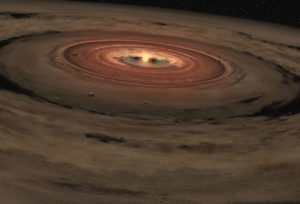
Artist’s conception of a protoplanetary disk from which planets form.
During today’s research group meeting, we discussed a paper from a few years ago from Lars Buchhave and colleagues that investigated the relationship between the composition of a planet-hosting star and the properties of its planets.
The discoveries of thousands of exoplanetary systems in the last few decades has revealed the bewildering variety of planets formed in our galaxy, and the richness of this planetary zoo probably reflects the wide range of conditions in which these planets formed.
Going back to the philosopher Kant, planets have been thought to form in disks of gas and dust leftover after their host star forms, and we now have a plethora of observational and theoretical evidence supporting this idea.
This idea means that the star and planets form mostly from the same source of material. However, while stars form directly out of the disk, the formation process for planets is a little pickier about what goes into the planets.
For example, the Sun is made almost entirely out of hydrogen and helium, elements that constitute most of the baryonic matter in the universe, while the Earth is made mostly of rocky elements, which are pretty rare in the universe. The gas giant Jupiter is kind of a mix – it’s mostly hydrogen and helium like the Sun, but it has more of the heavier elements than the Sun, all of which astronomers refer to as metals.
In their paper, Bucchave and colleagues report estimates of the ‘metallicities‘ or the amount of metals in lots of planet-hosting stars and try to figure if the type of planets around a star depends somehow on stellar metallicity.
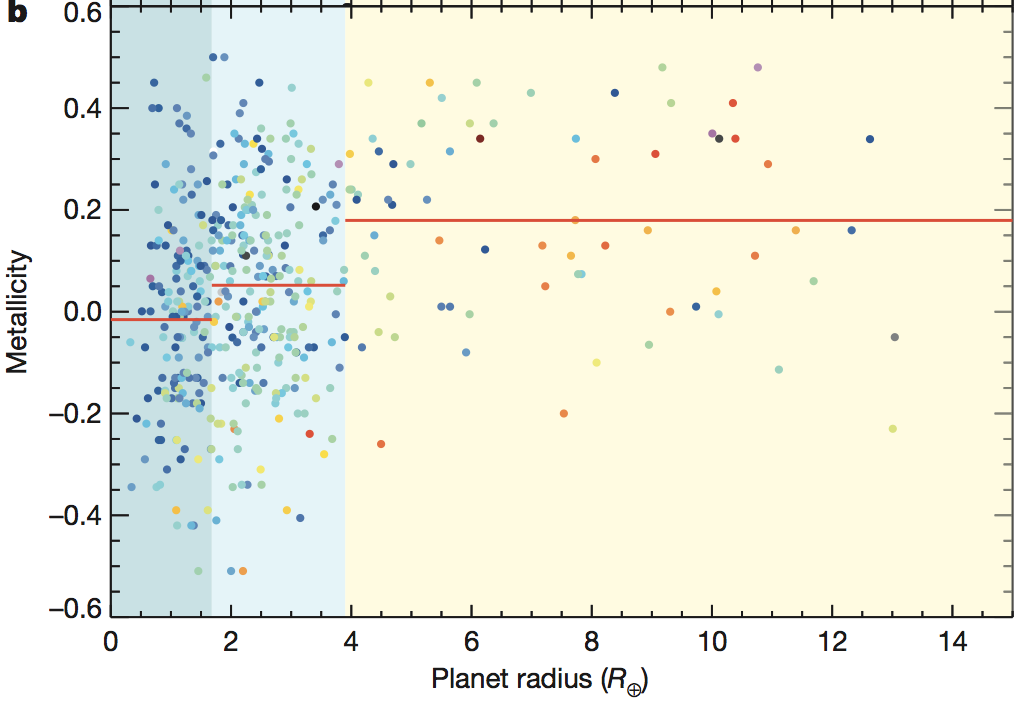
Figure 1 from Bucchave et al. (2014) shows the metallicities of stars vs. the radii (in Earth radii) of their planets. The horizontal red lines show the average metallicity for stars in that group.
Interestingly, the metallicities suggests there are three kinds of planetary systems – shown as dark blue, light blue, and yellow in the figure above. Big gaseous planets like Jupiter, with radii many times Earth’s, seem to form preferentially around stars with lots of metals, while small planets like the Earth aren’t as picky – they’ll form around stars with any metallicity. And planets with radii in between, about 2 to 4 times the Earth’s radius, they’re like Goldilocks and prefer stars with a little more metals but not too much.
What does all this mean? Astronomers think the protoplanetary disk (and therefore the star) might be required to have lots of planet-forming materials (that is, metals) in order to make big planets like Jupiter. On the other hand, forming small planets like the Earth apparently doesn’t take much because even stars with a tenth the Sun’s metals host them. Which all sort of makes sense.
But these results don’t answer everything. Why, for example, aren’t the stars with really big metallicities (the blue dots near the top left of the figure) always able to form big, Jupiter-like planets? This cluster of three blue dots are all members of the KOI-3083 planet system, whose star is Sun-sized but has almost three times more metals, but all the planets are smaller than Earth.
Could there be big planets in that system we haven’t found yet? Or maybe the planet formation process involves so much randomness (stochasticity) that a big metallicity only steers the system in the direction of big planets; it doesn’t force them in that direction. Like gently shepherding a toddler through a toy store – more often than not, you’ll end up with toys in your cart.
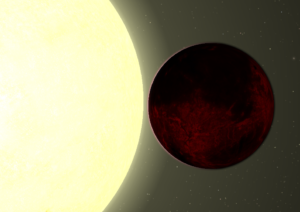
Artist’s conception of the ultra-short-period planet Kepler-78 b, discovered by Sanchis-Ojeda and colleagues in 2013.
An eyebrow-raising paper emerged recently from Prof. Josh Winn and colleagues about a type of planet near and dear to my heart, ultra-short-period planets, or USPs for short.
These planets are roughly the size of Earth and probably rocky but are hundreds of times closer to their host star than the Earth is to the Sun. These planets are so hot some have melted daysides and others are evaporating. Because they’re so much closer to their stars, ultra-short-period planets zip around their stars in just hours – hence the clunky name.
Our group, along with others, has suggested USPs might be the remnants of hot Jupiters (gas-giant planets close to their stars) that had their atmospheres ripped off. If so, we’d expect systems hosting USPs to resemble systems hosting hot Jupiters.
One distinctive feature of stars with hot Jupiters is that they have more iron (Fe) and other heavy elements in their atmospheres. Astronomers call the amount of heavy elements (“metals”) stellar metallicity. Hot-Jupiter host stars are heavy in metals probably because planets form from the same materials as the star and big planets need large amounts of metals to form. The same trend doesn’t seem to hold for small, roughly Earth-sized planets, though – small planets don’t seem to be as picky. So, if USPs are hot Jupiters that lost their atmospheres, their stars should also be metal-rich.
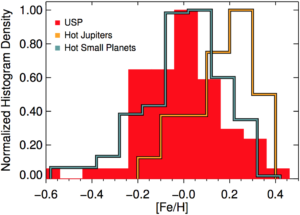
Figure 4 from Winn et al. (2017), showing the distribution of stellar metallicities for USP-hosting stars (red), hot Jupiter-hosting stars (orange), and stars hosting small but slightly longer period planets (blue).
But the recent paper from Winn and colleagues throws this origin story for USPs into doubt. In their study, they looked at metallicities for stars hosting USPs, stars hosting hot Jupiters, and those hosting small planets a bit farther out than USPs, all discovered by the Kepler Mission. The figure at left shows their results.
As expected, the orange curve for hot Jupiter hosts peaks toward higher metallicity (that is, toward bigger [Fe/H]-values), and if USPs are former hot Jupiters, the red histogram should look like the orange one.
Instead, it looks a lot like the blue one for smaller, farther out planets. This result suggests that USPs are just like their longer-period cousins – planets that have always been small, just with very short periods.
What to make of this? There’s some statistical wiggle room, allowing some, but not all, USPs to have been hot Jupiters, but Winn’s analysis says no more than 46%. It’s also possible that the boundaries between what Winn calls “hot Jupiters” and what he calls “hot small planets” could be refined by additional analysis, shifting the orange curve down a bit (or maybe shifting the blue curve up).
But the chances that USPs experienced a dramatic and brutal origin are a little slimmer now. Maybe that’s a good thing – it says the universe might be a little bit less violent than we thought.
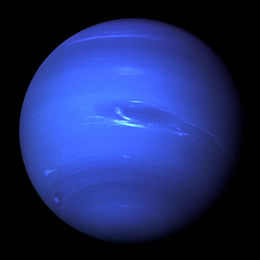
The Kepler/K2 Mission has revolutionized astronomy, having more than decupled the number of known and suspected exoplanets in just the last few years. Although we can extrapolate things we’ve learned from these distant planets to infer things about our own solar system, data from the mission have not impacted directly on our understanding of the solar system because the mission has not observed solar system objects, until now. For a recent paper, Jason Rowe and colleagues collected K2 observations of Neptune to look for the signatures of global oscillations in the planet.
What does that mean? All planets and stars exhibit intrinsic oscillations as seismic waves permeate their interiors – essentially they are ringing like giant celestial bells. On the Earth, detailed studies of these seismic waves have taught us loads about Earth’s interior, and the soon-to-launch Insight Mission will do much the same for Mars. We also study the Sun’s interior this way because we can watch as waves that originate deep within the Sun bounce around on the surface. For the Sun, these waves cause tiny oscillations in brightness every few minutes.
In the last decades, a lot of work has gone into looking for such oscillations for in gas and ice giants in our solar system, but aside from very cool indirect signatures in the rings of Saturn, no one has clearly detected global oscillations in the giant planets. Using the Kepler spacecraft, Rowe and colleagues set out to detect global oscillations by watching Neptune for 80 days. Unfortunately, in spite of a tremendous effort, they did not detect any clear oscillations from Neptune.
But amazingly, they were able to detect variations in brightness due to the Sun’s global oscillations. This is a little like seeing someone signaling with a flashlight by looking at a mirror in which the light is being reflected, only with the flashlight and mirror 4 billion kilometers apart.
The movie below shows the Kepler observations of Neptune as the planet meandered across the field of view. Keep in mind that the solar oscillations are VERY small, and the oscillations in brightness apparent in the movie are due to Neptune’s motion in the field, NOT due to the Sun. To see those oscillations, you’d need to be a computer.